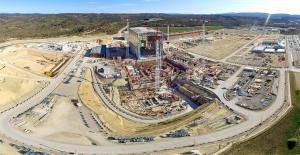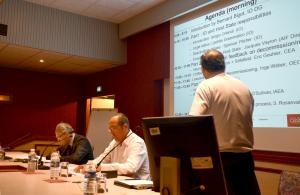Thinking ahead to decommissioning
Nine years before the operational campaign at ITER kicks off, some people are already thinking ahead to the final plasma shot and beyond.
David Torcy, who works as a nuclear engineer in the Remote Handling & Radioactive Materials Division, is one of them.
"The end of ITER's operational campaign will be followed by a 20-year decommissioning period that is divided into distinct de-activation and dismantling stages. As we design and build our systems today, it is important to think in advance about the requirements of these stages and make sure that, for our nuclear components, we plan in advance for accessibility, maintenance, removal and tooling. If we wait until the installation is complete it will be too late!"
The ITER Agreement, signed in 2006, foresees 20 years of operation followed by a five-year deactivation phase that will be managed by the ITER Organization before handover to the Host state, France, for dismantling and waste disposal. The ITER Organization and the Host State will conduct decommissioning and manage dismantling waste on the basis of financing received through a decommissioning fund, provisioned during ITER operation.
From the earliest days of the ITER design, in accordance with Host country regulations, the objective has been to optimize the waste management process by reducing radiotoxicity and total quantity. Selecting low-activation materials like austenitic steel, optimizing the design to limit the exposure of ex-vessel components to activation, and re-employing components or parts of components—all of these measures contribute to limiting the solid and liquid waste that will result from ITER operation.
A defined reference state has been identified for the end of the de-activation period that details just how the machine must be left to France. Among the requirements is the ITER Organization's responsibility of removing and storing all tritium, vacuuming all dust, removing all activated components such as the divertor and the blanket, and removing cooling water circuits.
On 10 June, the ITER Remote Handling & Radioactive Materials Division, Agence Iter France and the French Alternative Energies and Atomic Energy Commission, CEA, hosted a decommissioning forum that was attended by all of the actors involved in this final ITER phase—ITER Organization managers, technical responsible officers from ITER and the Domestic Agencies, designers in charge of components inside of nuclear buildings, and Legal Affairs.
The aims of the workshop were multiple: to recall the sharing of responsibilities between the ITER Organization and France, to raise awareness on decommissioning issues in the licensing process among the technical and decommissioning officers, and to present design and construction guidelines to facilitate the future deactivation and dismantling phases in accordance with French regulations.
Experts were also present from international organizations such as the OECD Nuclear Energy Agency (on monitoring activities) and the International Atomic Energy Agency (return-on-experience from decommissioning activities) to allow ITER to benchmark its plans against that of other facilities.
"At this stage of the project, the important thing is to integrate dismantling feasibility into the design of the machine in order to facilitate handling down the road; for this reason, a member of the Safety Department and CEA experts are present during design reviews to make recommendations to the ITER Organization regarding decommissioning and raise issues whenever they arise. The final assessment of feasibility will take place at the end of ITER operation, when the operator will submit a final safety report on dismantling," explains Joelle Elbez-Uzan, head of the Environmental Protection & Nuclear Safety Division.
"Over the years, due to evolutions in both the regulation and the ITER design, we have had to monitor the feasibility of the decommissioning scenario," says David. "We need to be sure that we don't just hand over the keys of the facility with no knowledge of processes for dismantling and impossible tasks to perform. The workshop helped us to clarify roles and responsibilities and make sure that our designers know what we expect from them. Moreover as we get closer to operation, the time is also right to identify possible optimizations of the scenario. This approach is in line with the general interest of fusion facilities."



